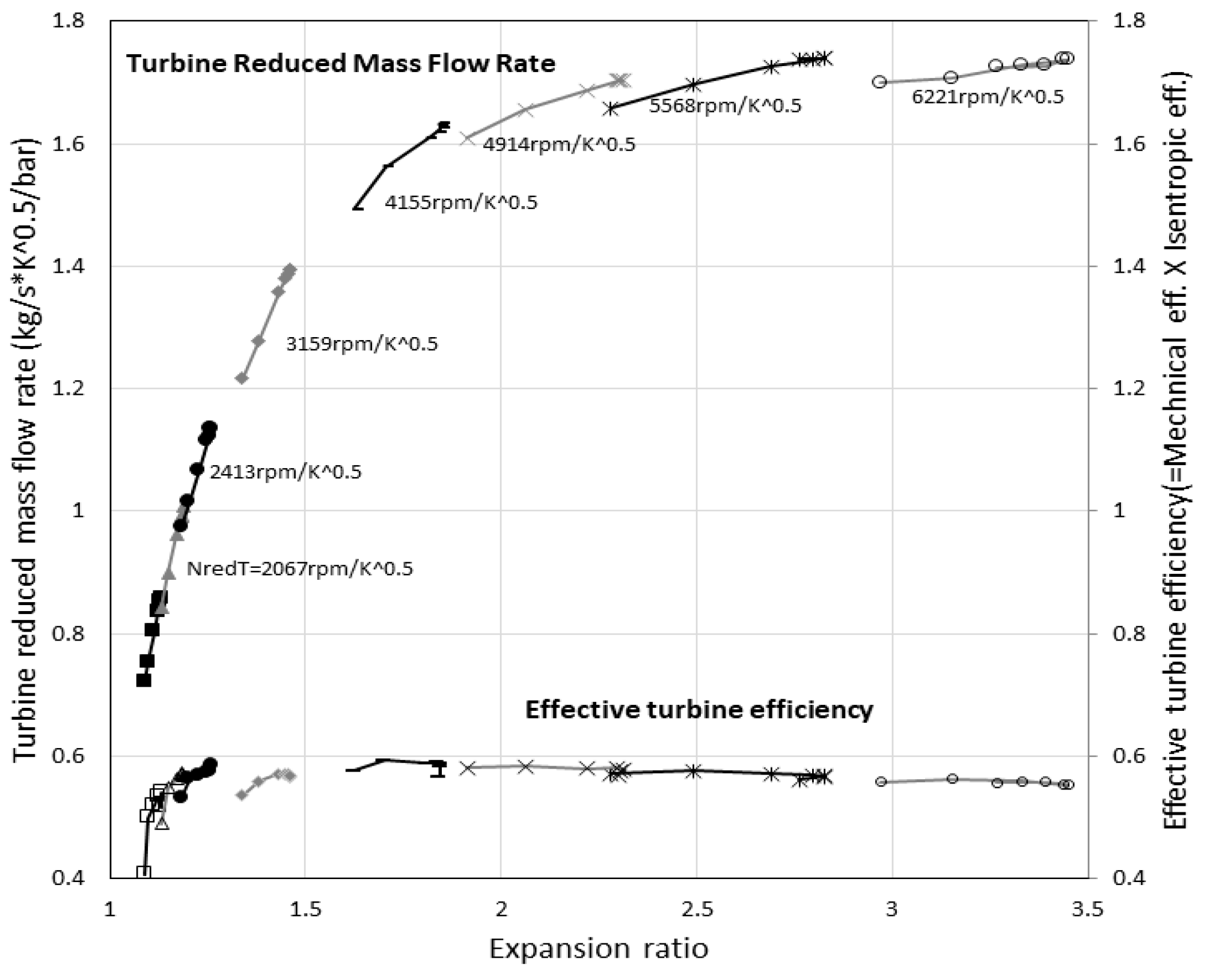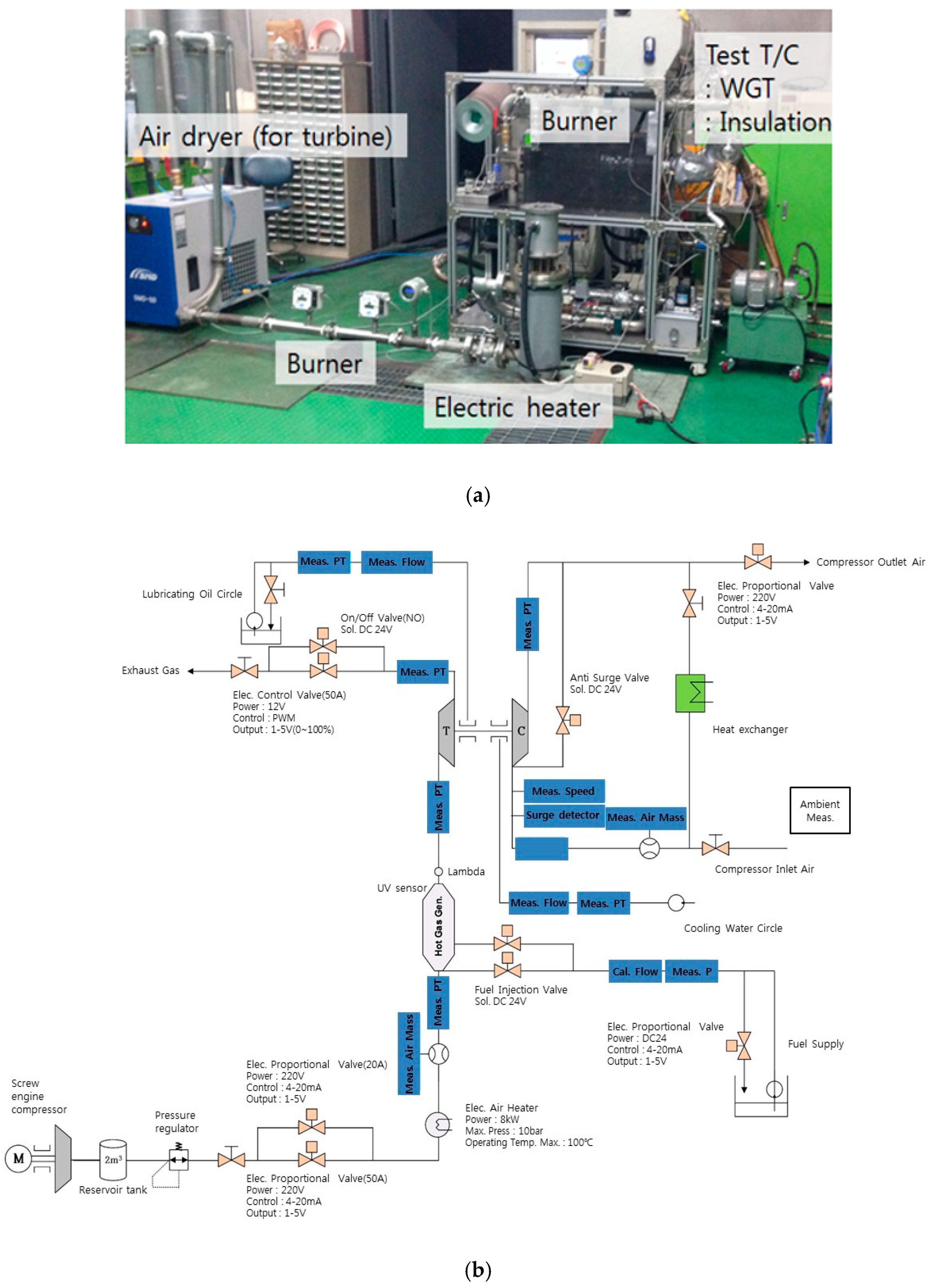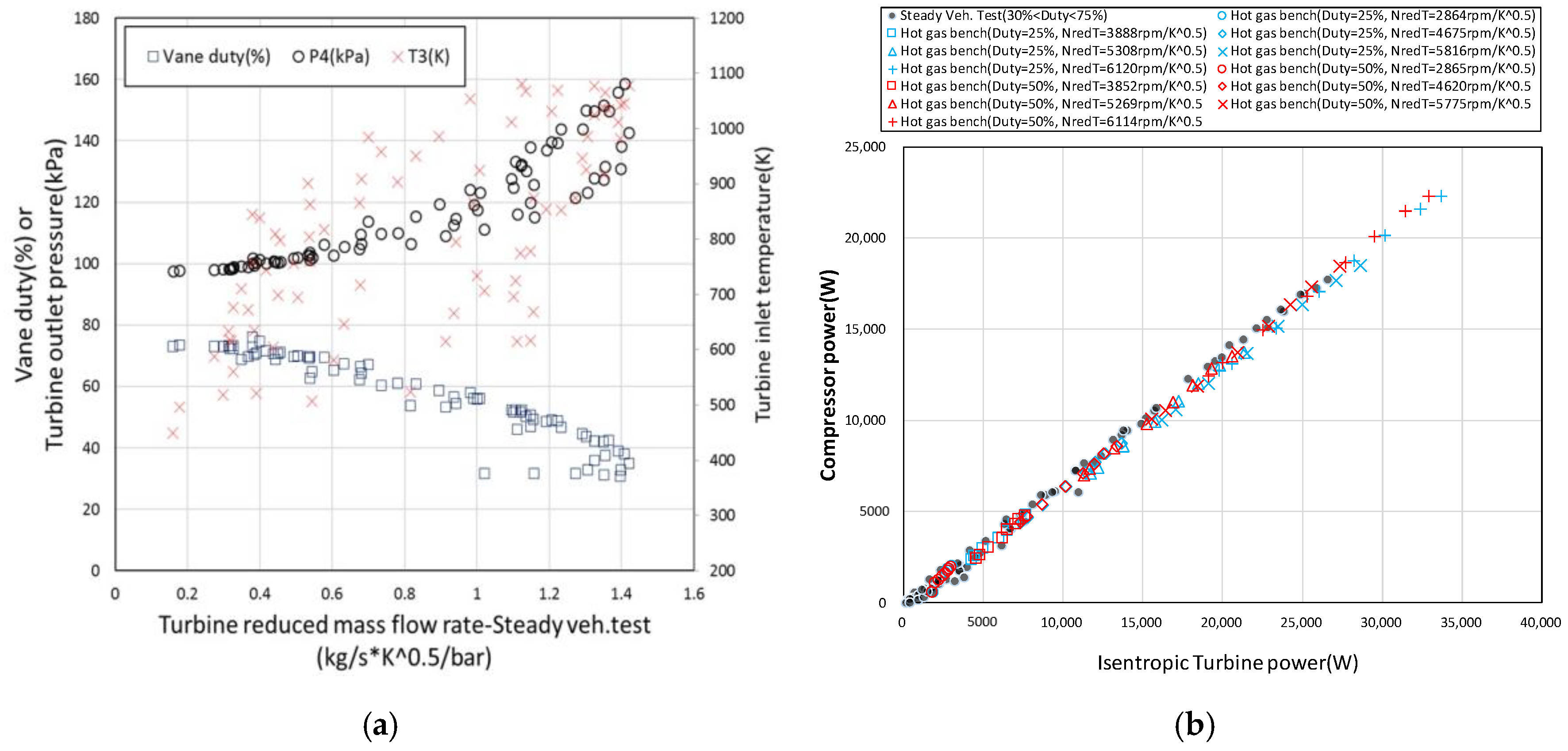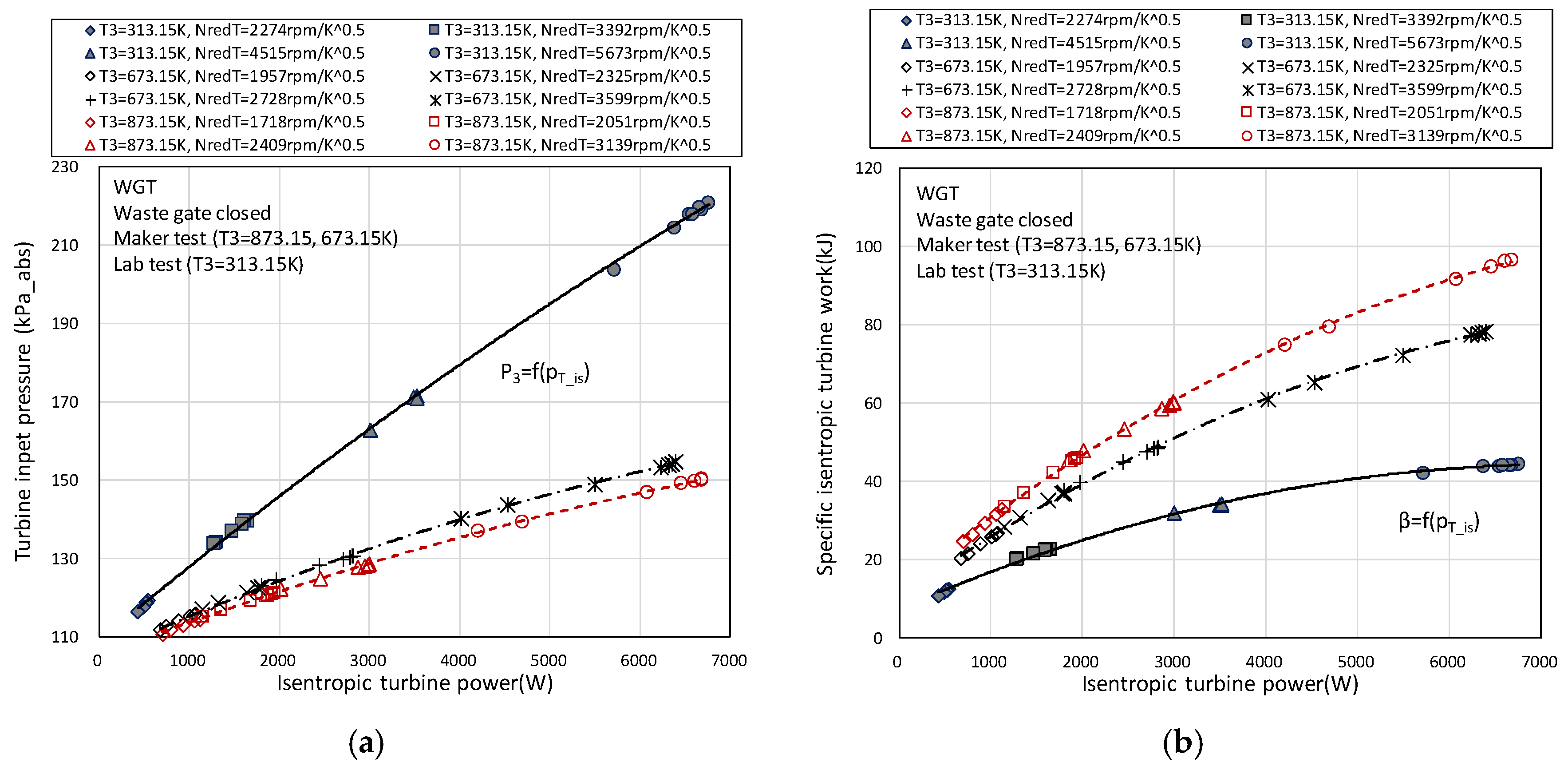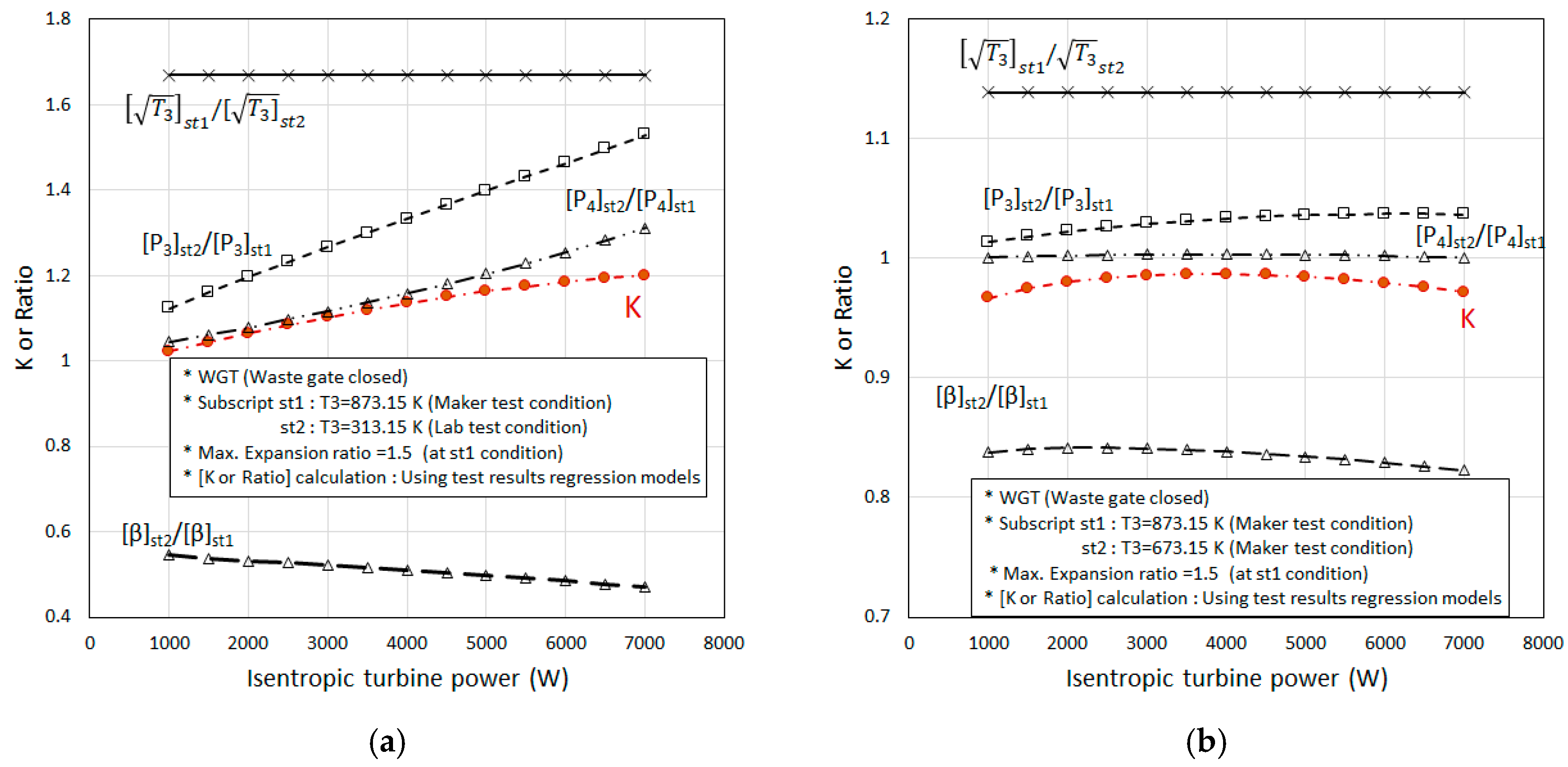1. Introduction
Recently, turbocharged engines have become an important technical solution for improving the fuel economy of vehicles [
1].
Meanwhile, the development of engine and turbocharger simulation technologies for turbocharger matching and control development for turbocharged engine development have become important technical challenges [
2,
3,
4].
In many cases, the performance characteristics of the turbocharger used in a simulation are obtained from a performance test using standardized hot gas bench test conditions [
5,
6].
However, the hot gas bench test with low backpressure characteristics of the test equipment, fixed turbine inlet temperature, and steady-state flow conditions has limitations in reproducing actual engine operating conditions and expanding the turbine test range. Therefore, various studies are being conducted to incorporate the utilization of extended performance predictions and test results for engine development and simulations [
7,
8,
9,
10].
In addition, since the compressor and the turbine are connected by a single shaft, a problem exists in which the operation range of the turbine is limited according to the surge and choke limitations of the compressor [
5].
In turbochargers, internal heat exchanges between the compressor, the turbine, the coolant, the lubrication oil, and the atmosphere occur concurrently.
This heat transfer causes temperature measurement errors in the after compressor temperature and the before and after turbine temperature in the middle and low speed ranges (in particular, the range of up to approximately 0.4 to 0.5 times the maximum rotational speed of the compressor is relatively small before and after the temperature difference), which is the turbocharger condition during actual engine operation. These measurement errors make it impossible to perform accurate measurements of isentropic efficiency [
11].
Therefore, a cold gas test, which sets the turbine inlet temperature as similar to the compressor temperature, has been used to investigate the distortion of the compressor efficiency due to heat exchange with the goal of correcting the efficiency [
11,
12].
In another study, a compressor efficiency correction method was proposed through an experiment on the change in turbine inlet temperature [
13].
On the other hand, various methods for expanding the turbine operating range have been provided [
9,
10], and a closed loop test method has been proposed to avoid the surge and choking areas on the compressor side to expand the turbine expansion ratio range [
5].
Turbine efficiency can also be expressed as a function of the turbine blade speed ratio, which is calculated from the turbine rotation speed, expansion ratio, and inlet temperature. In addition, a method for expanding the blade speed ratio range by changing the turbine inlet temperature or introducing a pulsating flow has been proposed [
14].
As such, many studies using various turbine operating conditions (temperature and pressure, etc.) have been carried out to evaluate the turbocharger efficiency accurately and expand the turbine performance evaluation range.
There have also been studies on the effect of turbine operating conditions on turbine flow rate characteristics.
In general, the turbine mass flow rate performance obtained through performance tests is presented as the reduced turbine mass flow rate performance corrected to the inlet pressure and temperature, considering the aerodynamic turbine characteristics. In many cases, engine simulation programs assume that the reduced turbine mass flow rate is not affected by the turbine inlet temperature.
However, some studies have produced experimental results reflecting the effect of turbine inlet temperature changes on the reduced turbine mass flow rate [
15].
In the turbine inlet temperature variation experiments (530 K and 850 K), the reduced turbine mass flow rate increased at the same expansion ratio as the turbine inlet temperature increased [
15]. On the other hand, a VGT (Variable-geometry turbocharger) turbine inlet temperature experiment was carried out in a wider temperature range (305 K to 973 K), and the results of the turbine inlet temperature change were found to affect the evaluation result of the reduced mass flow rate of the turbine [
16]. Both studies explain that the changes in the centrifugal force of the gas flow in the turbine housings were the main cause of the performance change.
These studies further explain that the changes in the reduced turbine mass flow rate due to temperature were on the aerodynamic side of the turbine, independent of compressor conditions.
However, actual turbine operation is related to compressor operating conditions. Therefore, to understand the reduced turbine mass flow rate performance characteristics under various turbine operating conditions, a study that considers both the compressor and turbine operating characteristics is required.
In this study, the turbine power state is related to the compressor power state, and the effects of the turbine inlet temperature and the turbine backpressure on the reduced turbine mass flow rate performance are explained. In addition, the principle of the explanation was used to correct the performance results of the reduced turbine mass flow rate test under different turbine operating conditions.
It is hoped that the results of this study will contribute to various turbine-related studies, such as studies on improving the compatibility of experimental results between gas benches, increasing the accuracy of engine models, and expanding the application of low-temperature experiments.
3. Power Balance-Based Reduced Turbine Mass Flow Rate Correction Method
3.1. Basic Correction Equation and Assumption
In this study, the power relation between the compressor and the turbine was used to obtain the correction equation of the reduced turbine mass flow rate according to the turbine operating conditions (turbine inlet temperature and turbine backpressure).
The first assumption is that there are two turbine operating conditions with the same compressor power performance.
At this time, the power balance can be summarized as Equation (11) based on Equation (6).
In this case, by substituting Equation (2), Equation (7), and Equation (8) into Equation (11), the relationship between the compressor power and reduced turbine mass flow rate under two operating conditions is defined by Equation (12).
Therefore, the reduced turbine mass flow rate in the two cases where the compressor power is the same but the operating conditions of the turbine is different are finally summarized in Equation (13) using the correction factor K (Equation (14)).
Equation (14) shows that K is affected by the turbine backpressure and turbine inlet temperature, as well as the turbine efficiency, turbine expansion ratio, and specific isentropic turbine work.
3.2. Simplification of the Correction Equation
To correct the reduced turbine mass flow rate to the reference conditions using Equation (14), each operating condition and effective turbine efficiency must be known. The pressure and temperature parameters in Equation (14) can be preset because they are either target values or dependent on test bench characteristics, but effective turbine efficiency generally requires conditional testing. This implies that all experiments must be performed according to the turbine operating conditions, thus making it the biggest constraint that limits the effectiveness and construction purpose of the basic correction equation.
Therefore, after analyzing the experimental results, the method for setting the efficiency term in Equation (14) was reviewed, and the reliability verification of the correction result was performed using the simplified correction equation.
The WGT tests in this study included very low turbine inlet temperature conditions (313.15 K) and high-temperature (573.15–873.15 K) experiments. Therefore, additional compressor power correction was performed because the measured compressor power at high turbine inlet temperature conditions presented relatively large distortions due to heat transfer from the turbine [
11,
13,
17].
In the case of WGT, various turbine inlet temperature condition gas bench tests were performed, and the construction of the heat transfer equation using the temperature change test results was possible. The relevant method is briefly presented below [
11,
13].
Assuming that no coolant is supplied during the experiment and only heat transfer by conduction exists, the heat transfer rate to compressor () can be expressed as Equation (15).
Coefficients
and
are values related to heat conduction that can be determined as minimizing differences when the compressor efficiency was corrected using turbine inlet variation tests. The representative temperature of the compressor
is the algebraic average of the inlet and outlet temperature of air [
11,
13]:
Figure 7a shows the effective turbine efficiency obtained from the gas bench test of WGT for the expansion ratio, which is a general expression method. As shown in the results, under the conditions of an expansion ratio of 1.6 or higher is confirmed, and similar and constant efficiency characteristics are presented despite the turbine inlet temperature and rotation speed changes. However, at lower expansion ratio conditions, there is a large difference in efficiency among the different turbocharger operating conditions.
On the other hand,
Figure 8a,b show effective turbine efficiency for compressor power and isentropic turbine power. The compressor power and isentropic turbine power in the low expansion ratio regions where rapid changes in effective turbine efficiency occur are relatively low (see
Figure 7b), thus reducing the dispersion of efficiency. In addition, this representation offers the characteristic in which the same compressor rotational speed region exists in a similar compressor power or isentropic turbine power region, thereby reducing interference due to friction loss according to the rotational speed when comparing the efficiency characteristics.
Figure 9 shows the relationship between the compressor power and isentropic turbine power results of the experiment on the commercial gas bench of WGT (turbine inlet temperature 573.15–873.15 K) and the lab-made gas bench (turbine inlet temperature 313.15 K).
Because effective turbine efficiency is the ratio of compressor power to isentropic turbine power, this type of relationship review makes it more suitable for characterizing the effective turbine efficiency at various operating conditions.
The results show that the compressor power for isentropic turbine power shows similar characteristics, despite the temperature changes and the results of experiments on different benches.
In addition, because this linear relationship has similar characteristics in all rotational speed conditions, the influence of rotational speed on reduced turbine mass flow rate correction is considered negligible.
On the other hand,
Figure 10 shows the results of the VGT experiment to examine the relationship between compressor power and isentropic turbine power under more random conditions. In vehicle testing, the engine operation was adjusted over a wide range, so the operating temperature, pressure, and vane (PWM) duty ranges of the VGT were very wide and, at the same time, each operating condition could be formed in various combinations.
Figure 10a shows the operating conditions of the turbine during the vehicle test. In the vehicle test, the VGT operated under conditions in which the VGT vane PWM duty was approximately 30% 75%, the turbine inlet temperature was approximately 473.15 to 1073.15 K, and the turbine backpressure was approximately 100 to 160 kPa.
However, the relationship between isentropic turbine power and compressor power obtained from gas bench experiments with a turbine inlet temperature of 873.15 K and vane duties of 25% and 50% shown in
Figure 10b existed in a single line with the vehicle test results.
From the above review, assuming that the isentropic turbine power for compressor power being the same in two cases where the turbine operating conditions are different may cause some errors to occur, the efficiency term in Equation (14) can be eliminated.
The assumption that the isentropic turbine work for compressor power in both states is the same means that the turbine efficiency at the same (ratio of effective turbine efficiency ≈1 in Equation (14)) compressor output is the same, even if the turbine operating conditions are different.
Accordingly, based on the assumptions made in this study, the efficiency term in Equation (14) can be eliminated and summarized in Equation (17).
3.3. Verification of Correction Results
The experimental results and Equation (17) were used to correct the reduced turbine mass flow rate, and the calculation process is shown in
Figure 11. The basic assumption of Equation (14) is that the two turbine operating conditions are set to have the same compressor power, but in this case, the regression model of all parameters (turbine inlet pressure, specific isentropic turbine work, etc.) should be constructed using the compressor power. However, the regression model was constructed using isentropic turbine power based on the assumptions made in Equation (17) (the ratio of effective turbine efficiency is close to 1) to restrict the use of compressor operation information.
Figure 12 shows an example of the parameters required for the calculation process in
Figure 11. All parameters are presented according to isentropic turbine power and consist of a multi-dimensional regression model for isentropic turbine power.
Using these regression models, the reduced turbine mass flow rate correction factor K (Equation (17) and correction results at the same isentropic turbine power can be obtained.
Corrected reduced turbine mass flow rates after these calculations should be based on expansion ratios under standard conditions. Thus, this correction process involved both the expansion ratio and the reduced turbine mass flow rate. The correction of the expansion ratio with the turbine inlet temperature is discussed in more detail in Chapter 4.2.
Based on these findings, it is possible to correct the reduced turbine mass flow rate under various turbine operating conditions. It is also possible to examine the reliability of the correction method by examining the calculation results. The correction of the reduced turbine speed was carried out by changing only the turbine inlet temperature () to the standard condition (commercial gas bench, = 873.15 K) while maintaining the turbine rotational speed in Equation (3).
Figure 13 shows the comparison of before and after the corrections of the WGT test results using the calculation process of
Figure 11.
As shown in
Figure 13a, it can be seen that there was a difference between the results of reduced turbine mass flow rate measurements for the expansion ratio depending on the gas bench used and the turbine inlet temperature conditions.
However, as shown in
Figure 13b, by correcting the reduced turbine mass flow rate while considering the turbine operating conditions, it can be seen that the experimental results of all conditions were corrected to the same value as the standard condition (commercial gas bench, T3 = 873.15 K).
These results indicate that the reduced turbine speed and reduced turbine mass flow rate were properly corrected.
4. Influence of Turbine Operating Conditions on Characteristics of Reduced Turbine Mass Flow Rate
4.1. Turbine Operating Conditions and Reduced Turbine Mass Flow Rate Correction Factor K
If one can assume the value of the correction factor K between the two turbine operating conditions, then the correction calculation for Equation (17) can be greatly simplified. Therefore, it is necessary to investigate the influence of the turbine operating environment on K.
Figure 14 shows the correction factor K and parameter ratio (from Equation (17)) when the used gas bench and the turbine inlet temperature differed. Due to the difference in the backpressure characteristics of the two gas benches (
Figure 14a, the turbine inlet pressure ratio and turbine outlet pressure ratio of the commercial and lab-made benches at the same isentropic turbine power increased as the isentropic turbine power increases. However, in
Figure 14b, which shows the results of a commercial gas bench test with relatively low backpressure, the change in the pressure ratio and correction factor K was relatively small despite the increase in isentropic turbine power.
Therefore, it can be seen that changes in the K value according to the isentropic turbine power depended on the variation of the turbine inlet or outlet pressure due to the turbine backpressure characteristics of each gas bench rather than the change in the turbine inlet temperature.
Based on the WGT’s experimental results, the ratio of the correction factor K to the turbine inlet pressure (
) and the ratio of the correction factor K to the turbine outlet pressure (
) for isentropic turbine power are presented in
Figure 15. In
Figure 15b, the correction factor K divided by the turbine outlet pressure ratio shows a trend relatively close to 1 regardless of the isentropic turbine power. In particular, in the case of a turbine inlet temperature of 313.5 K, the difference of the ratio of the correction factor K to the turbine inlet pressure is increased in
Figure 15a, but in the case of
Figure 15b, the change in the correction factor K to the turbine outlet pressure ratio is relatively small.
4.2. Influence of Turbine Inlet Temperature on Expansion Ratio Correction
The correction process presented in
Figure 11 involves the correction of the expansion ratio as well as the reduced turbine mass flow rate with the correction factor K.
If the relationship between the expansion ratios for two turbine operating conditions is known, Equation (17) can be used to predict and correct the reduced mass flow rate in different turbine operating conditions without further experimentation.
In constructing the expansion ratio correction equation according to the turbine outlet temperature variation, for calculation simplicity, the ratio of K and the turbine inlet pressure ratio is assumed to be 1 (considering the results of
Figure 15b), as shown in Equation (18).
If Equation (18) is substituted into Equation (17), the relationship between the expansion ratio and the turbine inlet temperature is simply summarized as Equation (19). In addition, the specific turbine isentropic work (
) of Equation (19) can be calculated as a function of only the expansion ratio and temperature using Equation (8).
Thus, once two turbine inlet temperature conditions are established, the relationship between the two expansion ratios can be established.
When using Equation (19) to correct the turbine flow performance results measured in any turbine inlet temperature conditions to standard experimental conditions (turbine inlet temperature 873.15 K), the equation for the expansion ratio is given by Equation (20).
Experimental data are not required to derive Equation (20), and the physical properties of air are used. In Equation (20), coefficients
a and
b are expressed as a function of temperature, and the results of the expansion ratio correction and coefficients
a and
b are shown in
Figure 16.
However, when the performance measured at the turbine inlet temperature 873.15 K (standard condition) is corrected to any target turbine inlet temperature condition, the expansion ratio correction equation is as shown in Equation (21). The coefficients
c and
d are then expressed as a function of the target turbine inlet temperature.
Figure 17 shows the corrected expansion ratio and coefficients
c and
d with temperature changes.
Figure 18. shows the result of correcting the turbine expansion ratio during the turbine inlet temperature variation test using Equation (20) to the expansion ratio based on a turbine inlet temperature of 873.15 K.
The expansion ratio in
Figure 18a is the calculation result using the fitting model from each experiment.
Figure 18b shows the result of applying the correction equation for recalculation, assuming a turbine inlet temperature of 873.15 K.
Despite the assumption of Equation (18), the expansion ratios of all the experiments are relatively well corrected.
In conclusion, when the turbine inlet temperature is lowered, the expansion ratio is shown to be relatively high, but it is confirmed that the expansion ratio can be easily corrected using Equations (20) and (21).
